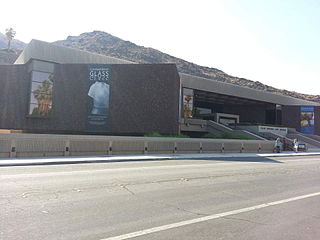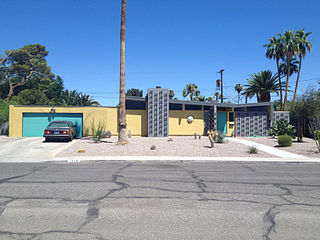
Desert Hot Springs, also known as DHS, is a city in Riverside County, California, United States. The city is located within the Coachella Valley geographic region, sometimes referred to as the Desert Empire. The population was 25,938 at the 2010 census, up from 16,582 at the 2000 census. The city has undergone rapid development and high population growth since the 1970s, when there were 2,700 residents.

Diamonds Are Forever is a 1971 spy film and the seventh in the James Bond series produced by Eon Productions. It is the sixth and final Eon film to star Sean Connery, who returned to the role as the fictional MI6 agent James Bond, having declined to reprise the role in On Her Majesty's Secret Service (1969).
Albert Frey was a Swiss-born architect who established a style of modernist architecture centered on Palm Springs, California, United States, that came to be known as "desert modernism".

John Edward Lautner was an American architect. Following an apprenticeship in the mid-1930s with Frank Lloyd Wright, Lautner opened his own practice in 1938, where he worked for the remainder of his career. Lautner practiced primarily in California, and the majority of his works were residential. Lautner is perhaps best remembered for his contribution to the development of the Googie style, as well as for several Atomic Age houses he designed in the late 1950s and early 1960s, which include the Leonard Malin House, Paul Sheats House, and Russ Garcia House.
Emerson Stewart Williams, FAIA was a prolific Palm Springs, California-based architect whose distinctive modernist buildings, in the Mid-century modern style, significantly shaped the Coachella Valley's architectural landscape and legacy.

Mid-century modern (MCM) is an American design movement in interior, product, graphic design, architecture, and urban development that was popular from roughly 1945 to 1969, during the United States's post–World War II period. The term, employed as a style descriptor as early as the mid-1950s, was reaffirmed in 1983 by Cara Greenberg in the title of her book, Mid-Century Modern: Furniture of the 1950s, celebrating the style that is now recognized by scholars and museums worldwide as a significant design movement.

The Chemosphere is a modernist house in Los Angeles, California, designed by John Lautner in 1960. The building, which the Encyclopædia Britannica once called "the most modern home built in the world", is admired both for the ingenuity of its solution to the problem of the site and for its unique octagonal design.

Ronald Wayne Burkle is an American billionaire businessman. He is co-founder and managing partner of The Yucaipa Companies, LLC, a private equity and venture capital firm that specializes in underperforming U.S. companies in the distribution, logistics, food, retail, consumer and light industrial sectors.

The Palm Springs Art Museum was founded in 1938, and is a regional art, natural science and performing arts institution for Palm Springs and the Coachella Valley, in Riverside County, California, United States.

Palm Springs is a desert resort city in Riverside County, California, United States, within the Colorado Desert's Coachella Valley. The city covers approximately 94 square miles (240 km2), making it the largest city in Riverside County by land area. Every other square mile of the city is part of the Agua Caliente Band of Cahuilla Indians reservation land. Traditionally the Cahuilla refer to the Palm Springs area as Sec-he or Se-Khi.

The Kaufmann House is a house located in Palm Springs, California, that was designed by architect Richard Neutra in 1946.
Donald Allen Wexler was an influential Mid-Century modern architect whose work is predominantly in the Palm Springs, California, area. He is known for having pioneered the use of steel in residential design.
Films made in the 1970s featuring the character of James Bond included Diamonds Are Forever, Live and Let Die, The Man with the Golden Gun, The Spy Who Loved Me, and Moonraker.

William Krisel was an American architect best known for his pioneer designs of mid-century residential and commercial architecture. Most of his designs are for affordable homes, especially tract housing, with a modern aesthetic.
The Palm Springs School of Architecture - often called Desert Modernism - is a regional style of post-war architecture that emerged in Palm Springs, California. Many of the architects who pioneered this style became world-renowned later in their own careers. Numerous buildings and homes by these architects remain in the Coachella Valley.
Arthur Dea Elrod, Jr. was an American interior designer, perhaps best known for the Elrod House in Palm Springs, California designed by the architect John Lautner and built for Elrod in 1968.
Marmol Radziner is a design-build practice based in Los Angeles that was founded in 1989 by American architects Leo Marmol, FAIA, and Ron Radziner, FAIA. Specializing in residential, commercial, hospitality, cultural, and community projects, the firm offers a full range of design services, including architectural design, construction, landscape design, interior design, furniture design, jewelry design, and Modern restoration.

Modernism Week is a 501(c)(3) organization which provides public education programming fostering knowledge and appreciation of modern architecture, the mid-century modern architecture and design movement, the Palm Springs School of Architecture, as well as contemporary considerations surrounding historic preservation, cultural heritage, adaptive reuse, and sustainable architecture. Modernism Week provides annual scholarships to local students pursuing college educations in the fields of architecture and design and supports local and state organizations' efforts to preserve and promote the region's modern architecture. The organization is centered in the greater Palm Springs, California area in the Coachella Valley which is home to a significant collection of extant residential and commercial buildings designed in the mid-century modern vernacular.
The Hope Residence is a house at 2466 Southridge Drive in Palm Springs, California. It is 23,600 sq ft (2,190 m2) in size. The house was built for the American entertainers Bob and Dolores Hope and completed in 1979. The house is noted for its large undulating triangular roof, with a large central light shaft.












